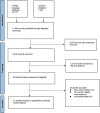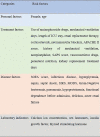A systematic review and meta-analysis of risk factors for intensive care unit acquired weakness
- PMID: 36316900
- PMCID: PMC9622703
- DOI: 10.1097/MD.0000000000031405
A systematic review and meta-analysis of risk factors for intensive care unit acquired weakness
Abstract
Background: The aim of this meta-analysis is to systematically evaluate and summarize the risk factors of intensive care unit acquired weakness (ICU-AW), to provide evidence-based evidence for the formulation of prevention strategies for ICU-AW.
Methods: PubMed, EMBASE, Web of Science, CBM (China Biology Medicine, China), Chinese National Knowledge Infrastructure, Chinese WANFANG, and VIP will be searched to define relevant risk factors for ICU-AW. The databases search period is from January 1, 2005 to August 13, 2021. The Newcastle Ottawa Scale (NOS) is used to evaluate the quality of the included studies. RevMan 5.3 analysis software will be used for meta-analysis.
Results: This systematic review and meta-analysis included a total of 12 cohort studies, including 9 international journals and 3 Chinese journals, with a total of 1950 patients, of which 856 had ICU-AW. The results showed that the significant risk factors for ICU-AW included female (odds ratio [OR] = 1.34, 95% confidence interval [CI]: 1.06-1.71; P = .02), mechanical ventilation days (OR = 3.04, 95% CI: 1.82-4.26; P < .00001), age (OR = 6.33, 95% CI: 5.05-7.61; P < .00001), length of intensive care unit (ICU) stay (OR = 3.78, 95% CI: 2.06-5.51; P < .0001), infectious disease (OR = 1.67, 95% CI: 1.20-2.33; P = .002), renal replacement therapy (OR = 1.59, 95% CI: 1.11-2.28; P = .01), use of aminoglucoside drugs (OR = 2.51, 95% CI: 1.54-4.08; P = .0002), sepsis related organ failure assessment (SOFA) score (OR = 1.07, 95% CI: 0.24-1.90; P = .01), hyperglycemia (OR = 2.95, 95% CI: 1.70-5.11; P = .0001).
Conclusion: This meta-analysis provides comprehensive evidence-based on the assessment of the risk factors for ICU-AW, their multifactorial etiology was confirmed. This study indicated that female, mechanical ventilation days, age, length of ICU stay, infectious disease, renal replacement therapy, use of aminoglucoside drugs, SOFA score, and hyperglycemia are independent risk factors for ICU-AW. We have not found consistent evidence that corticosteroids, neuromuscular blockers, sepsis have any effect on ICU-AW risk.
Copyright © 2022 the Author(s). Published by Wolters Kluwer Health, Inc.
Conflict of interest statement
The authors have no conflicts of interest to disclose.
Figures















Similar articles
-
[Intensive care unit-acquired weakness of mechanically ventilated patients: prevalence and risk factors].Zhonghua Wei Zhong Bing Ji Jiu Yi Xue. 2019 Nov;31(11):1351-1356. doi: 10.3760/cma.j.issn.2095-4352.2019.11.008. Zhonghua Wei Zhong Bing Ji Jiu Yi Xue. 2019. PMID: 31898564 Chinese.
-
[Early incidence and prognosis of ICU-acquired weakness in mechanical ventilation patients].Zhonghua Wei Zhong Bing Ji Jiu Yi Xue. 2019 Jul;31(7):821-826. doi: 10.3760/cma.j.issn.2095-4352.2019.07.005. Zhonghua Wei Zhong Bing Ji Jiu Yi Xue. 2019. PMID: 31441403 Chinese.
-
[Traditional Chinese therapy in the treatment of ICU-acquired weakness: a Meta-analysis].Zhonghua Wei Zhong Bing Ji Jiu Yi Xue. 2023 May;35(5):538-544. doi: 10.3760/cma.j.cn121430-20220301-00191. Zhonghua Wei Zhong Bing Ji Jiu Yi Xue. 2023. PMID: 37308238 Chinese.
-
Effect of mechanical ventilation and pulmonary rehabilitation in patients with ICU-acquired weakness: a systematic review and meta-analysis.Ann Palliat Med. 2021 Sep;10(9):9594-9606. doi: 10.21037/apm-21-1928. Ann Palliat Med. 2021. PMID: 34628885
-
Risk prediction models for intensive care unit-acquired weakness in critically ill patients: A systematic review.Aust Crit Care. 2025 Jan;38(1):101066. doi: 10.1016/j.aucc.2024.05.003. Epub 2024 Jul 15. Aust Crit Care. 2025. PMID: 39013706
Cited by
-
ICU-acquired weakness in critically ill patients at risk of malnutrition: risk factors, biomarkers, and early enteral nutrition impact.World J Emerg Med. 2025;16(1):51-56. doi: 10.5847/wjem.j.1920-8642.2025.020. World J Emerg Med. 2025. PMID: 39906116 Free PMC article.
-
Airway management in patients with surgical treatment of oral cavity carcinoma.BMC Anesthesiol. 2025 Apr 23;25(1):195. doi: 10.1186/s12871-025-03048-4. BMC Anesthesiol. 2025. PMID: 40269692 Free PMC article.
-
Potential diagnostic tools for intensive care unit acquired weakness: A systematic review.Int J Nurs Stud Adv. 2025 Jan 27;8:100301. doi: 10.1016/j.ijnsa.2025.100301. eCollection 2025 Jun. Int J Nurs Stud Adv. 2025. PMID: 39995749 Free PMC article. Review.
-
Clinical characteristics and predictive biomarkers of intensive care unit-acquired weakness in patients with cardiogenic shock requiring mechanical circulatory support.Sci Rep. 2025 Jan 28;15(1):3535. doi: 10.1038/s41598-025-87381-1. Sci Rep. 2025. PMID: 39875476 Free PMC article.
-
Post-Intensive Care Syndrome as a Burden for Patients and Their Caregivers: A Narrative Review.J Clin Med. 2024 Oct 2;13(19):5881. doi: 10.3390/jcm13195881. J Clin Med. 2024. PMID: 39407940 Free PMC article. Review.
References
-
- Fan E, Cheek F, Chlan L, et al. . An official American Thoracic Society clinical practice guideline: the diagnosis of intensive care unit-acquired weakness in adults. Am J Respir Crit Care Med. 2014;190:1437–46. - PubMed
-
- Ramsay DA, Zochodne DW, Robertson DM, et al. . A syndrome of acute severe muscle necrosis in intensive care unit patients. J Neuropathol Exp Neurol. 1993;52:387–98. - PubMed
-
- Mirzakhani H, Williams JN, Mello J, et al. . Muscle weakness predicts pharyngeal dysfunction and symptomatic aspiration in long-term ventilated patients. Anesthesiology. 2013;119:389–97. - PubMed

